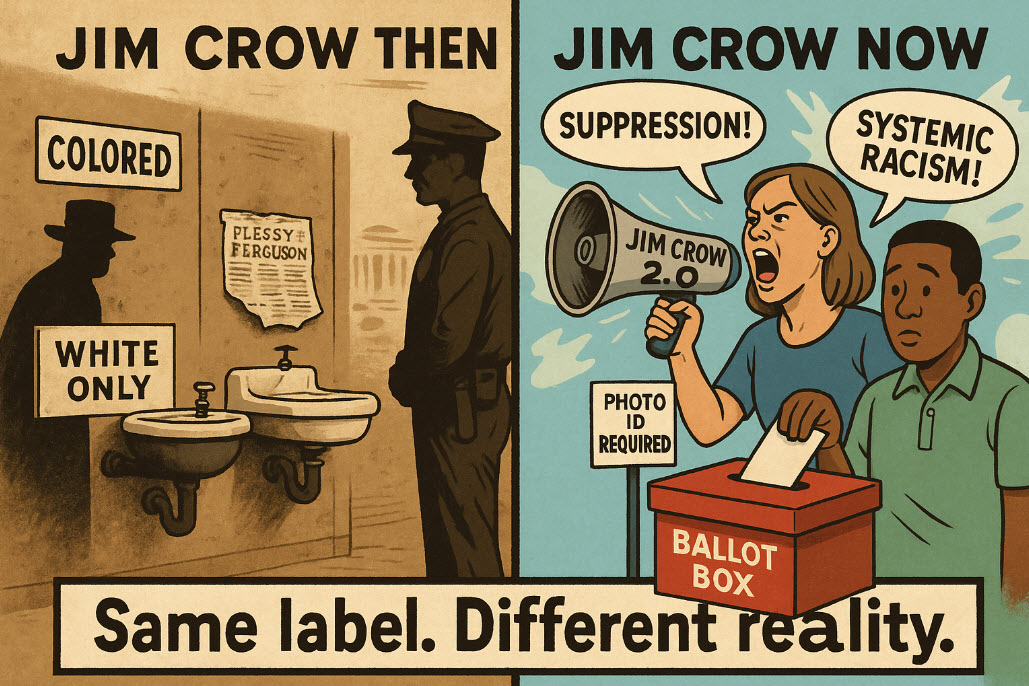What is “Jim Crow” and why do leftist Democrats constantly use this phrase in semantic warfare?
The phrase Jim Crow evokes one of the darkest and most oppressive chapters in American history. It refers not to a single law or policy but to a broad and pervasive system of legalized segregation, discrimination, and racial humiliation that spanned from the late 19th century through the mid-20th century. These laws were not merely social customs but were enforced through legislation, courts, and often violence.
Today, however, the term Jim Crow is often invoked by political activists, particularly on the Left, to describe policies or social conditions they consider systemically racist. But does this comparison hold? What are the implications of using a term so deeply rooted in a specific historical context to describe contemporary issues? And how should conservatives respond to this semantic strategy?
This article explores the origins of Jim Crow, its historical context and impact, and evaluates its modern usage as a political tool. We will examine the motivations behind the Left’s rhetorical use of the term and suggest constructive and principled conservative responses.
The Origins of “Jim Crow”
The term Jim Crow originated long before the laws it came to represent. It began as a derogatory character in 19th-century minstrel shows. In the 1830s, a white performer named Thomas Dartmouth Rice became famous for a song-and-dance routine in blackface called Jump Jim Crow. The act mocked African Americans, portraying them as lazy, ignorant, and buffoonish. The term Jim Crow quickly became a racial slur, used to demean and stereotype black Americans.
By the late 19th century, the phrase was repurposed to describe the system of state and local laws that codified racial segregation across the Southern United States. Thus, Jim Crow moved from being a fictional caricature to a legal and cultural reality.
The Rise of Jim Crow Laws
Following the Civil War and the abolition of slavery in 1865, the United States entered the Reconstruction era. Federal troops occupied the South, and laws were passed to guarantee the rights of newly freed slaves. The 13th, 14th, and 15th Amendments aimed to abolish slavery, grant citizenship, and protect voting rights for black Americans. During this brief period, African Americans saw unprecedented political involvement, with some being elected to local and national office.
However, after the end of Reconstruction in 1877, Southern states began enacting laws to restrict the newfound freedoms of black citizens. These laws—collectively known as Jim Crow laws—were designed to maintain white supremacy and control over African Americans through legal means.
Common features of Jim Crow laws included:
- Segregated public facilities: Separate schools, parks, transportation, restrooms, and drinking fountains for blacks and whites.
- Voting restrictions: Poll taxes, literacy tests, and grandfather clauses were implemented to disenfranchise black voters.
- Interracial marriage bans: Anti-miscegenation laws forbade marriages between whites and non-whites.
- Employment discrimination: Jobs were reserved for whites, while blacks were often relegated to menial labor.
These laws were upheld by state courts and the U.S. Supreme Court, most infamously in Plessy v. Ferguson (1896), which established the separate but equal doctrine.
The Impact of Jim Crow
The Jim Crow system was not just about legal segregation—it was enforced through social pressure, economic control, and violence. African Americans who violated social codes or resisted discrimination faced job loss, eviction, arrest, beatings, or lynching.
Organizations such as the Ku Klux Klan used terror to suppress black political participation and maintain white dominance. Meanwhile, black communities responded with resilience—building their own churches, schools, and businesses. Yet, opportunities remained unequal, and poverty was widespread.
The Jim Crow era stifled generations of African Americans, denying them basic civil rights and the chance to prosper freely in American society. It was a clear, codified system of racial oppression.
The Fall of Jim Crow
The collapse of Jim Crow laws came about through sustained civil rights activism, court cases, and changing public sentiment.
- Brown v. Board of Education (1954) overturned Plessy v. Ferguson, ruling that segregated schools were inherently unequal.
- The Civil Rights Act of 1964 banned segregation in public places and employment discrimination.
- The Voting Rights Act of 1965 outlawed discriminatory voting practices.
These legislative victories marked the official end of legalized Jim Crow segregation. While racism did not disappear, the state-sanctioned structure of racial oppression was dismantled.
The Modern Use of “Jim Crow”
Despite the historical specificity of Jim Crow laws, many leftist politicians and commentators have revived the term to describe various contemporary issues:
- Voter ID laws: Critics argue that requiring identification disproportionately affects minority voters and constitutes a new form of voter suppression.
- Mass incarceration: Michelle Alexander famously called the criminal justice system The New Jim Crow, arguing it functions to control black populations.
- Education and housing disparities: Some activists describe these inequalities as remnants or continuations of Jim Crow.
In 2021, President Joe Biden called Georgia’s new voting law “Jim Crow in the 21st century.” Similar claims have been made about other state-level voting reforms.
Is the Comparison Appropriate?
To equate modern challenges—however real or imagined —with Jim Crow laws is to commit a historical distortion. Jim Crow was a legally enforced, systematically brutal regime of racial apartheid. By contrast, today’s voter ID laws apply to all citizens, and the vast majority of Americans—black and white—support them.
Likewise, while disparities exist in criminal justice and education, these are complex issues influenced by a multitude of factors, including personal choices, cultural trends, and economic policies—not merely institutional racism.
The use of Jim Crow as a rhetorical bludgeon diminishes the suffering of those who actually lived under that regime. It also devalues meaningful conversations about current issues by replacing evidence with emotional manipulation.
The Left’s Motivation for Using the Term
Why does the Left invoke Jim Crow so freely?
- Emotional resonance: The term conjures powerful images of injustice. Using it generates immediate moral weight.
- Political leverage: Accusing opponents of promoting Jim Crow policies silences debate. After all, who wants to defend something associated with lynching and racial hatred?
- Narrative control: The Left often frames America as inherently racist, from its founding to the present. Reviving the Jim Crow label helps link the past to the present, reinforcing that narrative.
- Voter mobilization: By suggesting that civil rights are under threat, political activists galvanize minority voters and demonize conservative policies.
This is not merely hyperbole—it is strategic semantic warfare.
Semantic Warfare and Its Consequences
Language shapes reality. When the Left redefines words or imports historical terms into new contexts, they shift the terms of public debate. Consider the following examples:
- Redefining “racism”: Instead of personal prejudice, racism is now described as systemic power structures, making it impossible for some groups to be racist.
- “Equity” over equality: Equity demands equal outcomes, not just equal opportunity.
- “Violence” redefined: Words are labeled as violence, while actual violence (e.g., rioting) is called speech or activism.
Calling voter ID laws Jim Crow is part of this same project. It erases the difference between actual, codified segregation and policy disagreements in a pluralistic democracy. It’s not merely inaccurate—it’s manipulative.
Conservative Responses
So how should conservatives respond?
a. Reclaim the Moral High Ground
Point out the true nature of Jim Crow and how conservatives have supported civil rights legislation historically. For example, a higher percentage of Republicans than Democrats voted for the Civil Rights Act of 1964.
b. Insist on Historical Accuracy
Challenge the misuse of terms like Jim Crow. Demand precise language. Use examples and historical data to show the difference between voter ID laws and literacy tests, or between educational inequality and legally segregated schools.
c. Defend Policies on Merits
Explain how voter ID laws increase public confidence, prevent fraud, and are supported by minorities. Offer solutions that enhance access, like free IDs.
d. Expose the Manipulation
Call out semantic warfare. Show how redefining terms undermines honest debate. Point to shifting definitions of racism, equity, and justice as examples of ideological manipulation.
e. Promote Real Solutions
Conservatives must advance policies that empower all Americans: school choice, criminal justice reform, economic opportunity zones, and family support policies.
Conclusion
The term Jim Crow should be preserved as a solemn reminder of America’s history of racial oppression. It should not be wielded lightly or redefined to score political points. To equate policy disagreements in a democratic society with state-sanctioned apartheid is not only historically ignorant—it is morally reckless.
Conservatives must challenge this rhetorical overreach with clarity, confidence, and compassion. We must insist on truth in language and on justice rooted in principle, not propaganda. Only then can we preserve both the integrity of history and the promise of liberty for all.
S.D.G.,
Robert Sparkman
MMXXV
rob@christiannewsjunkie.com
RELATED CONTENT
Concerning the Related Content section, I encourage everyone to evaluate the content carefully.
If I have listed the content, I think it is worthwhile viewing to educate yourself on the topic, but it may contain coarse language or some opinions I don’t agree with.
Realize that I sometimes use phrases like “trans man”, “trans woman”, “transgender” , “transition” or similar language for ease of communication. Obviously, as a conservative Christian, I don’t believe anyone has ever become the opposite sex. Unfortunately, we are forced to adopt the language of the left to discuss some topics without engaging in lengthy qualifying statements that make conversations awkward.
Feel free to offer your comments below. Respectful comments without expletives and personal attacks will be posted and I will respond to them.
Comments are closed after sixty days due to spamming issues from internet bots. You can always send me an email at rob@christiannewsjunkie.com if you want to comment on something afterwards, though.
I will continue to add videos and other items to the Related Content section as opportunities present themselves.

